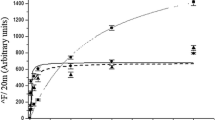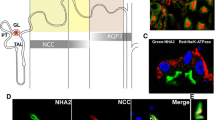Abstract
Hypertension is a major risk factor for kidney and cardiovascular disease. The treatment of hypertensive individuals by selected ACE inhibitors and certain di-and tripeptides halts the progression of renal deterioration and extends life-span. Renal reabsorption of these low molecular weight substrates are mediated by the PEPT1 and PEPT2 cotransporters. This study aims to investigate whether hypertension and ageing affects renal PEPT cotransporters at gene, protein expression and distribution as well as function in the superficial cortex and the outer medulla of the kidney. Membrane vesicles from the brush border (BBMV) and outer medulla (OMMV) were isolated from the kidneys of young Wistar Kyoto (Y-WKY), young spontaneously hypertensive (Y-SHR), and middle aged SHR (M-SHR) rats. Transport activity was measured using the substrate, β-Ala-Lys (AMCA). Gene expression levels of PEPT genes were assessed with qRT-PCR while renal localisation of PEPT cotransporters was examined by immunohistochemistry with Western Blot validation. The Km and Vmax of renal PEPT1 were decreased significantly in SHR compared to WKY BBMV, whilst the Vmax of PEPT2 showed differences between SHR and WKY. By contrast to the reported cortical distribution of PEPT1, PEPT1-staining was detected in the outer medulla, whilst PEPT2 was expressed primarily in the cortex of all SHR; PEPT1 was significantly upregulated in the cortex of Y-SHR. These outcomes are indicative of a redistribution of PEPT1 and PEPT2 in the kidney proximal tubule under hypertensive conditions that has potential repercussions for nutrient handling and the therapeutic use of ACE inhibitors in hypertensive individuals.








Similar content being viewed by others
Availability of data and materials
Available on request.
Code availability
NA.
References
Akarawut W, Lin CJ, Smith DE (1998) Noncompetitive inhibition of glycylsarcosine transport by quinapril in rabbit renal brush border membrane vesicles: effect on high-affinity peptide transporter. J Pharmacol Exptl Therapeut 287:684–690
Alghamdi OA, King N, Jones GL, Moens PDJ (2017a) Kinetic measurements of Di- and tripeptide and peptidomimetic drug transport in different kidney regions using the fluorescent membrane potential-sensitive dye, DiS-C3-(3). J Membr Biol 250:641–649
Alghamdi OA, King N, Jones GL, Moens PDJ (2017b) A new use of beta-Ala-Lys (AMCA) as a transport reporter for PEPT1 and PEPT2 in renal brush border membrane vesicles from the outer cortex and outer medulla. Biochim Biophys Acta 1860:960–964
Alghamdi OA, King N, Andronicos NM, Jones GL, Chami B, Witting PK, Moens PDJ (2018) Molecular changes to the rat renal transporters PEPT1 and PEPT2 due to ageing. Mol Cell Biochem 452:71–82
Brandsch M, Knutter I, Bosse-Doenecke E (2008) Pharmaceutical and pharmacological importance of peptide transporters. J Pharmacy Pharmacol 60:543–585
Burris JF, Tortorici MA, Mandic M, Neely M, Reed MD (2016) Dosage adjustments related to young or old age and organ impairment. J Clin Pharmacol 56:1461–1473
Bustin SA, Benes V, Garson JA, Hellemans J, Huggett J, Kubista M, Mueller R, Nolan T, Pfaffl MW, Shipley GL, Vandesompele J, Wittwer CT (2009) The MIQE guidelines: minimum information for publication of quantitative real-time PCR experiments. Clin Chem 55:611–622
Dalmasso G, Nguyen HT, Yan Y, Laroui H, Charania MA, Obertone TS, Sitaraman SV, Merlin D (2011) MicroRNA-92b regulates expression of the oligopeptide transporter PepT1 in intestinal epithelial cells. Am J Physiol 300:G52-59
Feld LG, Cachero S, Van Liew JB, Zamlauski-Tucker M, Noble B (1990) Enalapril and renal injury in spontaneously hypertensive rats. Hypertension 16:544–554
Frey IM, Rubio-Aliaga I, Klempt M, Wolf E, Daniel H (2006) Phenotype analysis of mice deficient in the peptide transporter PEPT2 in response to alterations in dietary protein intake. Pflugers Arch 452:300–306
Frey IM, Rubio-Aliaga I, Siewert A, Sailer D, Drobyshev A, Beckers J, de Angelis MH, Aubert J, Bar Hen A, Fiehn O, Eichinger HM, Daniel H (2007) Profiling at mRNA, protein, and metabolite levels reveals alterations in renal amino acid handling and glutathione metabolism in kidney tissue of Pept2-/- mice. Physiol Genomics 28:301–310
Health United States (2011) End-stage renal disease patients, by selected characteristics: United States, selected years 1980–2010. Centers for Disease Control and Prevention The USA
Knütter I, Wollesky C, Kottra G, Hahn MG, Fischer W, Zebisch K, Neubert RHH, Daniel H, Brandsch M (2008) Transport of angiotensin-converting enzyme inhibitors by H+/peptide transporters revisited. J Pharmacol Exptl Therapeut 327:432–441
Komatsu K, Frohlich ED, Ono H, Ono Y, Numabe A, Willis GW (1995) Glomerular dynamics and morphology of aged spontaneously hypertensive rats. Effects of angiotensin-converting enzyme inhibition. Hypertension 25:207–213
Lee RM, Delaney KH, Lu M (1995) Perindopril treatment prolonged the lifespan of spontaneously hypertensive rats. J Hypertens 13:471
Lin C-J, Akarawut W, Smith DE (1999) Competitive inhibition of glycylsarcosine transport by enalapril in rabbit renal brush border membrane vesicles: interaction of ACE inhibitors with high affinity H+/peptide symporter. Pharmaceut Res 16:609–615
Linz W, Becker RH, Schölkens BA, Wiemer G, Keil M, Langer KH (1998) Nephroprotection by longterm ACE inhibition with ramipril in spontaneously hypertensive stroke prone rats. Kid Int 54:2037–2044
National High Blood Pressure Education Program Coordinating Committee (1997) The sixth report of the joint national committee on prevention, detection, evaluation, and treatment of high blood pressure. Arch Internal Med 157:2413–2446
Nephropathy-REIN Study. (1997) Randomised placebo-controlled trial of effect of ramipril on decline in glomerular filtration rate and risk of terminal renal failure in proteinuric, non-diabetic nephropathy. The GISEN Group (Gruppo Italiano di Studi Epidemiologici in Nefrologia). Lancet 349:1857–1863
Rubio-Aliaga I, Daniel H (2008) Peptide transporters and their roles in physiological processes and drug disposition. Xenobiotica; the fate of foreign compounds in biological systems. Xenobiotica 38:1022–1042
Rubio-Aliaga I, Frey I, Boll M, Groneberg DA, Eichinger HM, Balling R, Daniel H (2003) Targeted disruption of the peptide transporter Pept2 gene in mice defines its physiological role in the kidney. Mol Cell Biol 23:3247–3252
Saito H, Okuda M, Terada T, Sasaki S, Inui K (1995) Cloning and characterization of a rat H+/peptide cotransporter mediating absorption of beta-lactam antibiotics in the intestine and kidney. J Pharmacol Therapeut 275:1631–1637
Saito H, Terada T, Okuda M, Sasaki S, Inui K (1996) Molecular cloning and tissue distribution of rat peptide transporter PEPT2. Biochim Biophys Acta 1280:173–177
Sarnak MJ, Levey AS, Schoolwerth AC, Coresh J, Culleton B, Hamm LL, McCullough PA, Kasicke BL, Kelepouris E, Klag MJ, Parfrey P, Pfeffer M, Raij L, Spinosa DJ, Wilson PA (2003) Kidney disease as a risk factor for development of cardiovascular disease: a statement from the American Heart Association Councils on Kidney in Cardiovascular Disease, High Blood Pressure Research, Clinical Cardiology, and Epidemiology and Prevention. Circ 108:2154–2169
Schwanhausser B, Busse D, Li N, Dittmar G, Schuchhardt J, Wolf J, Chen W, Selbach M (2011) Global quantification of mammalian gene expression control. Nature 473:337–342
Shen H, Smith DE, Yang T, Huang YG, Schnermann JB, Brosius FC III (1999) Localization of PEPT1 and PEPT2 proton-coupled oligopeptide transporter mRNA and protein in rat kidney. Am J Physiol 276:F658–F665
Smith DE, Pavlova A, Berger UV, Hediger MA, Yang T, Huang YG, Schnermann JB (1998) Tubular localization and tissue distribution of peptide transporters in rat kidney. Pharmaceut Res 15:1244–1249
Smith DE, Clemencon B, Hediger MA (2013) Proton-coupled oligopeptide transporter family SLC15: physiological, pharmacological and pathological implications. Mol Aspects Med 34:323–336
Thiab NR, King N, Jones GL (2015) Effect of ageing and oxidative stress on antioxidant enzyme activity in different regions of the rat kidney. Mol Cell Biochem 408:253–260
Tian Q, Stepaniants SB, Mao M, Weng L, Feetham MC, Doyle MJ, Yi EC, Dai HY, Thorrson V, Eng J, Goodlett D, Berger JP, Gunter B, Linseley PS, Stoughton RB, Aebersold R, Collins SJ, Hanlon WA, Hood LE (2004) Integrated genomic and proteomic analyses of gene expression in Mammalian cells. Mol Cell Proteomics 3:960–969
Tramonti G, Xie P, Wallner EI, Danesh FR, Kanwar YS (2006) Expression and functional characteristics of tubular transporters: P-glycoprotein, PEPT1, and PEPT2 in renal mass reduction and diabetes. Am J Physiol 291:F972-980
Vogel C, Abreu Rde S, Ko D, Le SY, Shapiro BA, Burns SC, Sandhu D, Boutz DR, Marcootte EM, Penalva LO (2010) Sequence signatures and mRNA concentration can explain two-thirds of protein abundance variation in a human cell line. Mol Systems Biol 6:400
Acknowledgements
This work was supported by the Saudi Ministry of Higher Education, University of New England, and University of Jeddah. We would also like to thank Mr. Brian Cross and Mr. Jonathon Clay for their excellent technical assistance.
Funding
This work was supported by the Saudi Ministry of Higher Education, University of New England, and University of Jeddah.
Author information
Authors and Affiliations
Contributions
OA performed the research, analysed the data and wrote the first draft of the paper. NK analysed the data and substantially edited the first draft. NA and BC and PW contributed methods to the paper and analysed the results. PM conceived the study and edited the final draft.
Corresponding author
Ethics declarations
Conflict of interest
None to declare.
Ethics approval
This study was approved by the Animal Ethics committee of the University of New England, and complied with the Guide for the care and use of laboratory Animals published by the US National Institute of Health (NIH Publication No. 85–23, revised 1996).
Additional information
Handling editor: S. Broer.
Publisher's Note
Springer Nature remains neutral with regard to jurisdictional claims in published maps and institutional affiliations.
Rights and permissions
About this article
Cite this article
Alghamdi, O.A., King, N., Andronicos, N.M. et al. Hypertension alters the function and expression profile of the peptide cotransporters PEPT1 and PEPT2 in the rodent renal proximal tubule. Amino Acids 54, 1001–1011 (2022). https://doi.org/10.1007/s00726-022-03154-4
Received:
Accepted:
Published:
Issue Date:
DOI: https://doi.org/10.1007/s00726-022-03154-4




